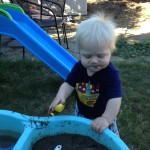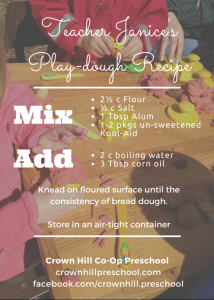How often do we hear people say that when they see children in a play-based curriculum preschool?
Yes, it looks like they are “only playing” but what are the children in this setting really doing?
Play is often talked about as a relief from serious learning. But for children, play is serious learning. Play is really the work of childhood. — Mr. Rogers
When children are actively playing they are actively learning

Preschooler playing in the sand and water.
It is through the joy of play that a child learns to enjoy learning — learning something new, taking a risk, challenging a thought, laughing, seeing something they have never seen before, making a connection between new learning and established knowledge. Play is all of that and more!
It is through play that children engage their creativity, foster language, develop problem-solving skills, reduce stress (yes, children have stress too!), create/strengthen the pathways in their brain, and learn how to interact in their world and with others.
Children need unstructured play opportunities:
- Time in the backyard with dirt and water
- Quiet time with animals and building blocks
- Creative time with a box of materials and art supplies
Children also need play opportunities that have been created for them:
- Sorting and categorizing materials that have been given to them (buttons, shells, math manipulatives)
- playdough with tools like scissors and pizza cutters for cutting
- magnifying glasses and plastic (or real) bugs for looking at with books or picture cards for identification
Even though the play opportunity has been set up for the child, the adult needs to follow the child’s lead. By giving the child the power to determine where the play goes, you allow the child to direct the learning. This is called emergent curriculum.
Play for young children is not recreation activity. It is not leisure time activity not escape activity. Play is thinking time for young children. It is language time. It is memory time, planning time, investigating time. It is organization of idea time, when the young child uses his mind and body and his social skills and all his powers in response to the stimuli he has met. — James L. Hymes, Jr U.S. Child Development Specialist, Author. Teaching the Child Under Six, Chapter 4 (1968)
So when your child is “just playing” remember that it is through play that children learn best. Play should be the central focus of learning for preschoolers. By giving your child open-ended, unstructured play opportunities you are creating the foundation for a life of learning and allowing your child to experience the joy that comes with that learning.

